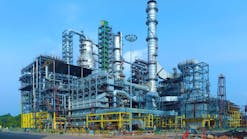Eco Waste Technologies has started up a super-critical water oxidation (SCWO) unit at Huntsman Corp.'s Austin research laboratories.
Eco Waste Technologies (EWT) calls the unit the world's first commercial facility employing SCWO technology for waste destruction.
The 5 gpm unit treats a variety of organic materials previously sent off site for use as auxiliary fuel or for disposal by incineration. It processes aqueous streams containing 10-15% organic content.
And because it is an effluent oxidation process, the Huntsman unit produces so little undesirable air constituents that an air permit is not required.
The SCWO unit produces two streams:
- A clean water effluent that can be discharged to a publicly owned treatment works or similar facility. Alternatively, the effluent can be recycled or reused as process water. Effluent samples from the system have met drinking water standards.
- Offgas comprising CO2 and water vapor-the natural reaction products from the oxidation of organics.
This offgas contains insignificant concentrations of NOx, particulates, ozone, and ammonia, says EWT.
The Huntsman unit will treat about 2 million lb/year of organic by-products from the research facility. This feed varies in composition, but amines are converted to pure N2 and carbon to CO2. The unit is designed to operate 24 hr/day.
SCWO PROCESS
EWT has been developing the technology since the company was formed in 1990. A 40 gph pilot plant has been operating at the University of Texas' J.J. Pickle Research Center since March 1991.
SCWO uses the unique properties that water acquires when it is heated and pressurized beyond its critical point (705 F. and 3,200 psi). The process is best suited for compounds too toxic or concentrated for biological treatment or treatment by other oxidation processes.
In the supercritical state, hydrocarbon solubility nears 100%, while inorganic solubility falls to near zero. Under these conditions, organic materials decompose rapidly via oxidation, with removal efficiencies of 99.99% or more.
The process uses a series of reformation and oxidation reactions to destroy aqueous organic wastes at concentrations of 2-20%. The reaction is often autogenous at organic concentrations greater than 5%.
Sludges are likely candidates for treatment by this method, as long as they are pumpable.
A flow diagram of the process is shown in Fig. 1.
Experiments conducted in the University of Texas pilot plant indicate that destruction levels greater than 99.99% can be expected for compounds such as: 2-butanol, o-cresol, p-chlorophenol, 2,4-dichlorophenol, 2,4,6-trichlorophenol, pentachlorophenol, pyridine, trichloroethylene, 2,4-dinitrotoluene, ethylene glycol, diethylene glycol, diethyl ether, methanol, acetic acid, and 2,4-dichlorophenoxy-acetic acid methyl ester.
Chlorinated hydrocarbons generally are rapidly oxidized to methanol and ethanol. The chlorine is converted to hydrochloric acid.
Tests by others indicate similar results for a number of other organic compounds, says EWT.
In its current design stage, the process is considered semicommercial size up to about 40 gpm. Future commercial designs will be 100 gpm or larger, says EWT.
DISPOSAL COSTS
The process is less expensive than incineration, and can be more economical than disposal in boilers, industrial furnaces, cement kilns, or landfills (Fig. 2).
SCWO also is competitive with off site deep-well injection, although deep-well injection, as a disposal method, is not favored by the Texas Natural Resources Conservation Commission, according to commissioner Pam Reed.
EWT projects treatment costs of 10-20cts/gal for commercial units. This amounts to substantial savings compared to off site incineration (Fig. 2).
REGULATORY SITUATION
The process should satisfy the U.S. Environmental Protection Agency's requirements as a totally enclosed treatment facility, says EWT. Most early applications of the process, however, are expected to involve:
- Discharging to a publicly owned treatment works
- Discharging to a plant permitted under the national pollutant discharge elimination system, or
- Discharging directly with a permit.
The probable final products from SCWO destruction are CO2, H2O, and N2 (and H2SO4, if the feed contains sulfur-bearing chemicals). EWT expects no problems in meeting air emissions standards because minimal, if any, NOx or SOx are formed. And because the reaction occurs in a supercritical fluid, no particulates are produced.
Because SCWO is used on site, processed wastes do not have to be shipped to a disposal facility. Treated waste can be held until testing is completed before being discharged. And since there are no hazardous by-products, the liabilities associated with improper disposal are eliminated.
Texas Natural Resource Conservation Commission has selected EWT's supercritical water oxidation process for its innovative technology program. This program was established in 1993 to identify and encourage the use of new technologies for reducing waste generation and pollutant emissions.
Copyright 1994 Oil & Gas Journal. All Rights Reserved.

